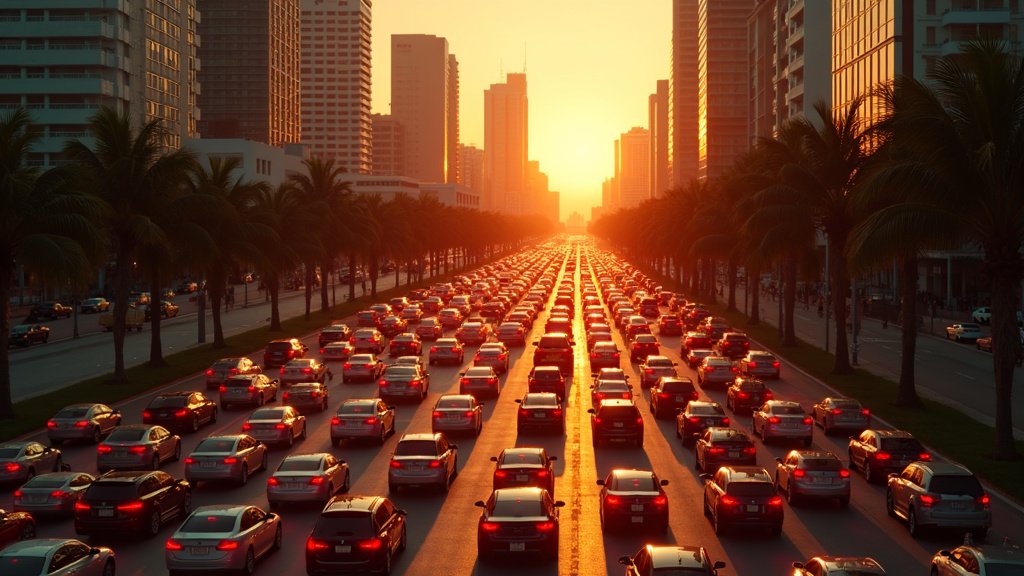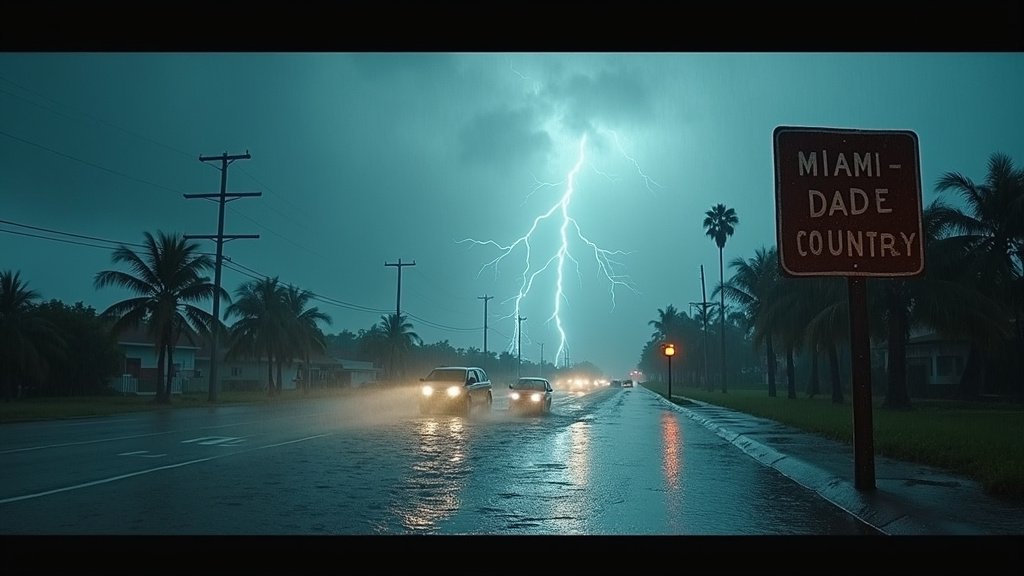Miami, a vibrant global hub renowned for its stunning beaches and dynamic culture, is increasingly defined by another, less glamorous characteristic: its pervasive and worsening traffic congestion. What was once an inconvenience has escalated into a significant economic burden and a major detractor from residents’ quality of life, drawing sharp contrasts for those accustomed to different urban environments. For a Cuban woman who relocated from Spain to Miami, the city’s chaotic traffic profoundly impacted her daily routine, underscoring systemic issues in South Florida’s mobility landscape. Her experience mirrors that of countless others navigating the sprawling metropolitan area, where driving remains a practical necessity amidst inadequate public transportation and a deeply entrenched car culture. [10]
The Unrelenting Grind: Miami’s Congestion Crisis
Recent data paints a stark picture of Miami’s traffic woes. In 2025, Miami was identified as the eighth most congested city in the United States, with drivers annually losing an average of 74 hours to traffic – a staggering equivalent of more than six full days spent idling in their vehicles. [14] This isn’t a new phenomenon; studies have consistently ranked Miami among the most gridlocked cities nationally and globally. In 2023, a report by INRIX Inc. revealed a 59% increase in traffic congestion compared to the previous year, placing Miami as the eighth most congested city worldwide. [14] The financial ramifications are substantial: this congestion costs the average Miami driver an estimated $1,773 annually due to lost time and increased fuel consumption, contributing to an overall regional economic impact that exceeds $3.6 billion, and potentially up to $4.5 billion, each year. [5, 9, 14, 16]
Commute times reflect this severe gridlock. The typical daily commute in Miami averages 58 minutes, meaning residents spend approximately 17 more hours stuck in traffic each year compared to a decade ago. [42] Traffic delays across the region escalated by 18% between 2019 and 2023, highlighting a persistent and growing challenge that affects productivity, increases stress, and diminishes the overall quality of life for millions. [21]
Roots of the Gridlock: Population Boom, Planning, and Preferences
Several interconnected factors fuel Miami’s enduring traffic problem:
Rapid Population Growth and Urban Sprawl: Miami-Dade County alone is home to approximately 3 million residents, with the larger metropolitan area exceeding 6 million. [6, 9, 23] Florida’s population has seen significant growth, with nearly 1 million people moving to the state in 2022 alone, and predictions of 26 million residents statewide by 2030. [6] Miami experienced the highest level of international immigration in the United States in 2023. [22] This influx, coupled with extensive urban sprawl, has stretched the existing road infrastructure beyond its limits. [9, 19, 22]
A Tourism and Economic Magnet: Miami’s allure as a global business and tourism destination further exacerbates congestion. Its thriving nightlife, easy access to airports, and status as a major international hub draw millions of visitors annually, adding to the sheer volume of vehicles on its roadways. [3, 22, 23, 28]
The Car Culture Conundrum: Despite the glaring congestion, Miami remains a city deeply rooted in car culture. An overwhelming 8 out of 10 residents possess a driver’s license, and 90% rely on personal vehicles for their commute. [21] Many residents, like the 18-year-old Fiorela Norori, acknowledge the shortcomings of public transit but prioritize the freedom and flexibility that private transportation offers, even if it means enduring significant delays. [22] This preference for personal vehicles has historical roots, evolving from a blend of necessity and a desire for luxury and individual expression, as seen in the city’s vibrant exotic car scene. [31, 36, 37, 38]
Underdeveloped Public Transportation: Miami’s public transportation system, managed by Miami-Dade Transit (MDT), includes Metrorail, Metromover, and Metrobus. While it is the largest public transit system in Florida, it lags significantly on a national scale, ranking 52nd among 100 U.S. cities for transit effectiveness. [10, 12] Critics often describe it as “woefully lacking,” slow, and unreliable. [10, 22, 27, 39] The Metrorail, for instance, has only expanded by roughly three miles since its mid-1980s inception, highlighting a historical underinvestment in transit infrastructure. [12, 21] This inadequacy forces more residents onto the roads, perpetuating the cycle of congestion.
Infrastructure Challenges and ‘Induced Demand’: Ongoing and often delayed road construction projects, such as the I-395/SR 836/I-95 Design-Build project (the “Signature Bridge”), further disrupt traffic flow and contribute to bottlenecks. [3, 22, 25, 30] Moreover, urban planners contend with the phenomenon of “induced demand,” where expanding road capacity, while offering temporary relief, ultimately encourages more people to drive, leading to renewed congestion in the long run. [22]
Charting a Course: Initiatives and the Road Ahead
Recognizing the urgency of the problem, Miami-Dade County and state agencies are pursuing various initiatives to alleviate the gridlock:
The SMART Plan: The Strategic Miami Area Rapid Transit (SMART) Plan is a cornerstone of the county’s efforts, aiming to expand and enhance public transit infrastructure. This ambitious program is advancing six rapid transit corridors (North, Northeast, East-West, Beach, Kendall, and South) and developing a Bus Express Rapid Transit (BERT) network. [2, 7, 17, 23] The South Corridor (South Dade TransitWay), converting existing bus lanes into a dedicated Bus Rapid Transit (BRT) system, is a significant step, projected to reduce travel times by up to 40% for commuters. [18, 21]
Public sentiment strongly supports these efforts; an 80% majority of Miami-Dade voters expressed a desire for more transit options in a recent ballot measure. [10] This public mandate has led Mayor Daniella Levine Cava to propose fully funding transit reserves, with a substantial $1.164 billion allocated to Transportation and Mobility. [10]
Infrastructure Upgrades and Smart Technology: Beyond new transit lines, Miami-Dade County is investing in its existing infrastructure. The Advanced Traffic Management System (ATMS) project aims to optimize traffic flow through upgraded central software, new controllers, and advanced detection systems at intersections. [13] The Florida Department of Transportation’s (FDOT) “Moving Florida Forward” initiative also commits $4 billion to major roadways, including two significant South Florida congestion relief projects. [20] Furthermore, exploring the use of artificial intelligence to identify and manage roadway incidents is underway. [20]
Rethinking Urban Planning: A critical long-term strategy involves decentralizing job and entertainment hubs. By developing mixed-use centers in areas like West Kendall and South Dade, planners hope to reverse existing commute patterns and reduce the overwhelming eastbound traffic flow into central Miami. [15]
Promoting Alternative Modes: Encouraging carpooling, ridesharing, and bike-sharing programs also form part of the solution, aiming to reduce the number of single-occupancy vehicles on the road. The City of Miami also offers traffic calming studies for neighborhoods concerned about speeding and cut-through traffic. [5, 24]
Conclusion
Miami’s struggle with traffic congestion is a multifaceted challenge, deeply intertwined with its rapid growth, unique urban landscape, and deeply ingrained car culture. While personal experiences like that of the Cuban woman from Spain highlight the daily frustrations, they also underscore a broader systemic issue that demands comprehensive and sustained attention. The ongoing efforts through the SMART Plan, infrastructure investments, and evolving urban planning strategies signal a concerted effort to move beyond a car-centric past. However, successfully navigating the road ahead will require not only significant financial investment and innovative solutions but also a fundamental shift in how residents perceive and utilize their transportation options to create a more livable, sustainable, and connected South Florida. [2, 10, 15, 21]





